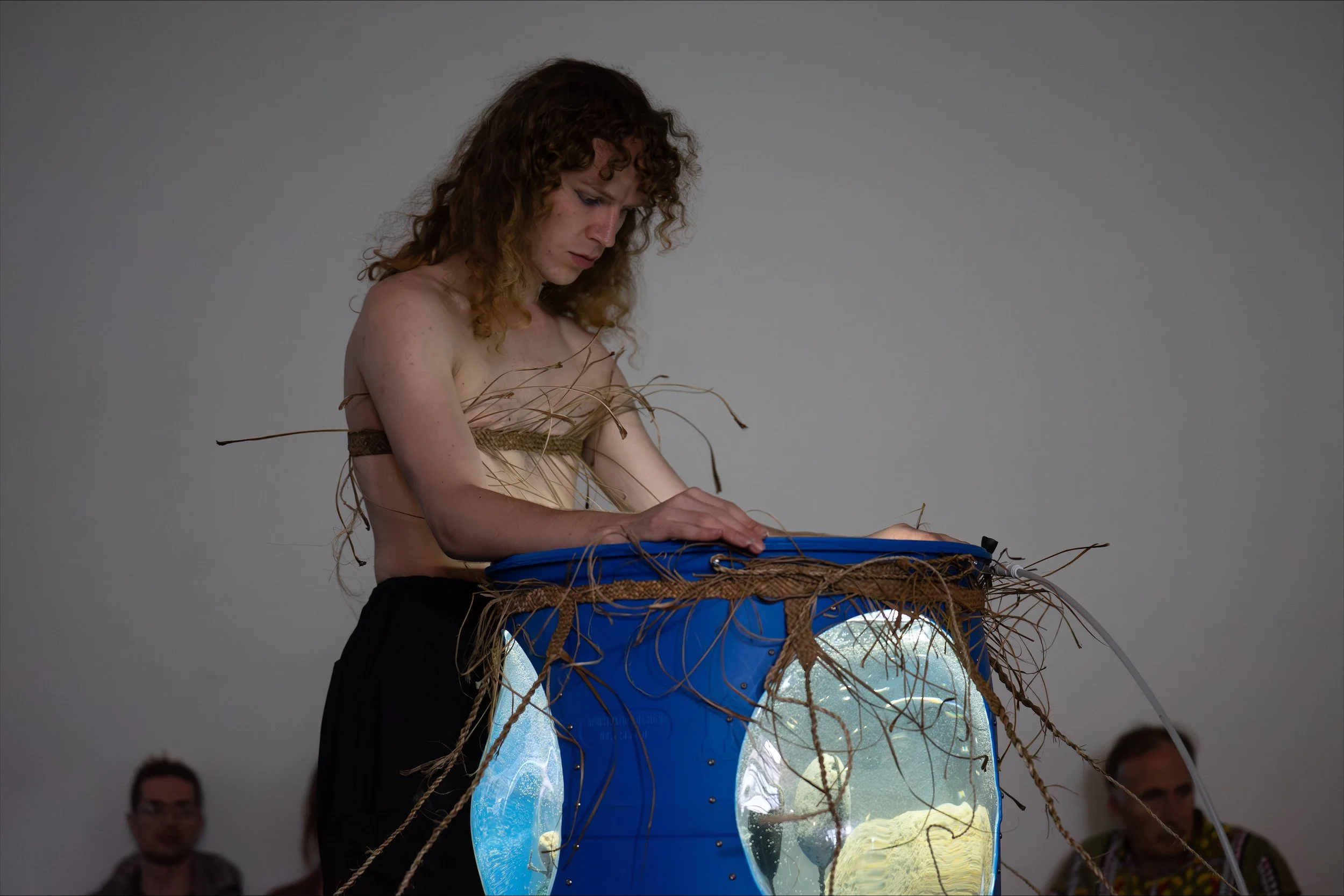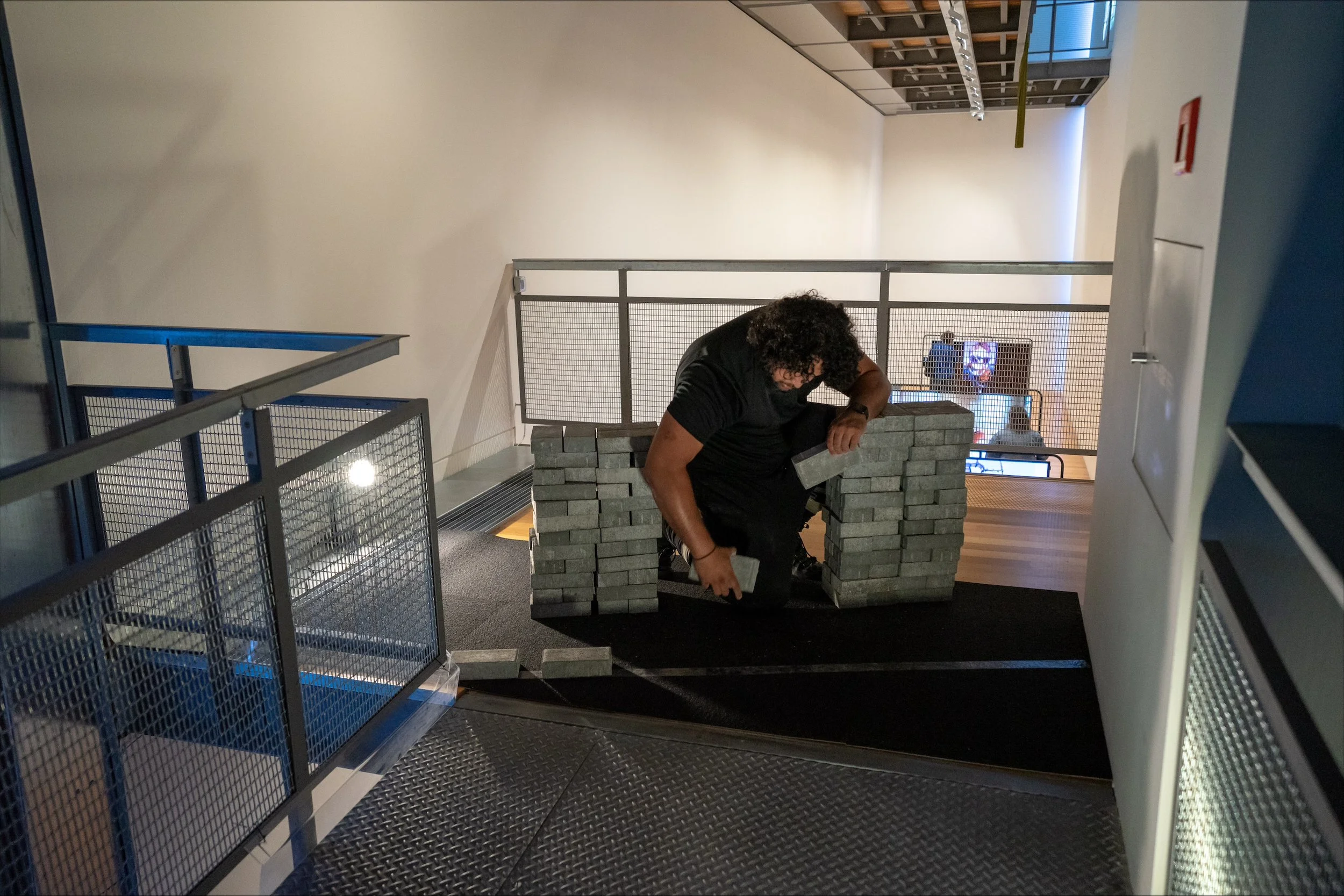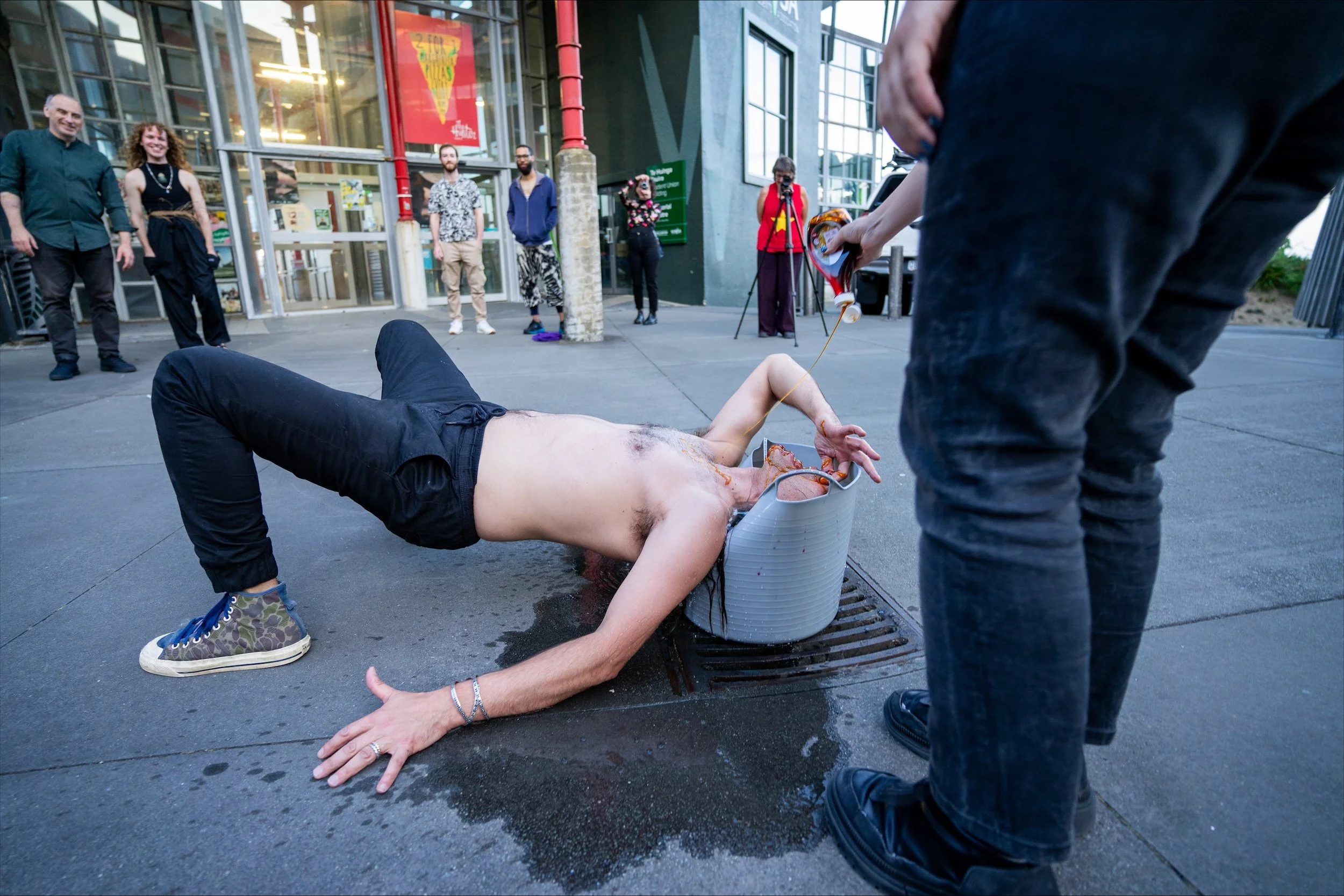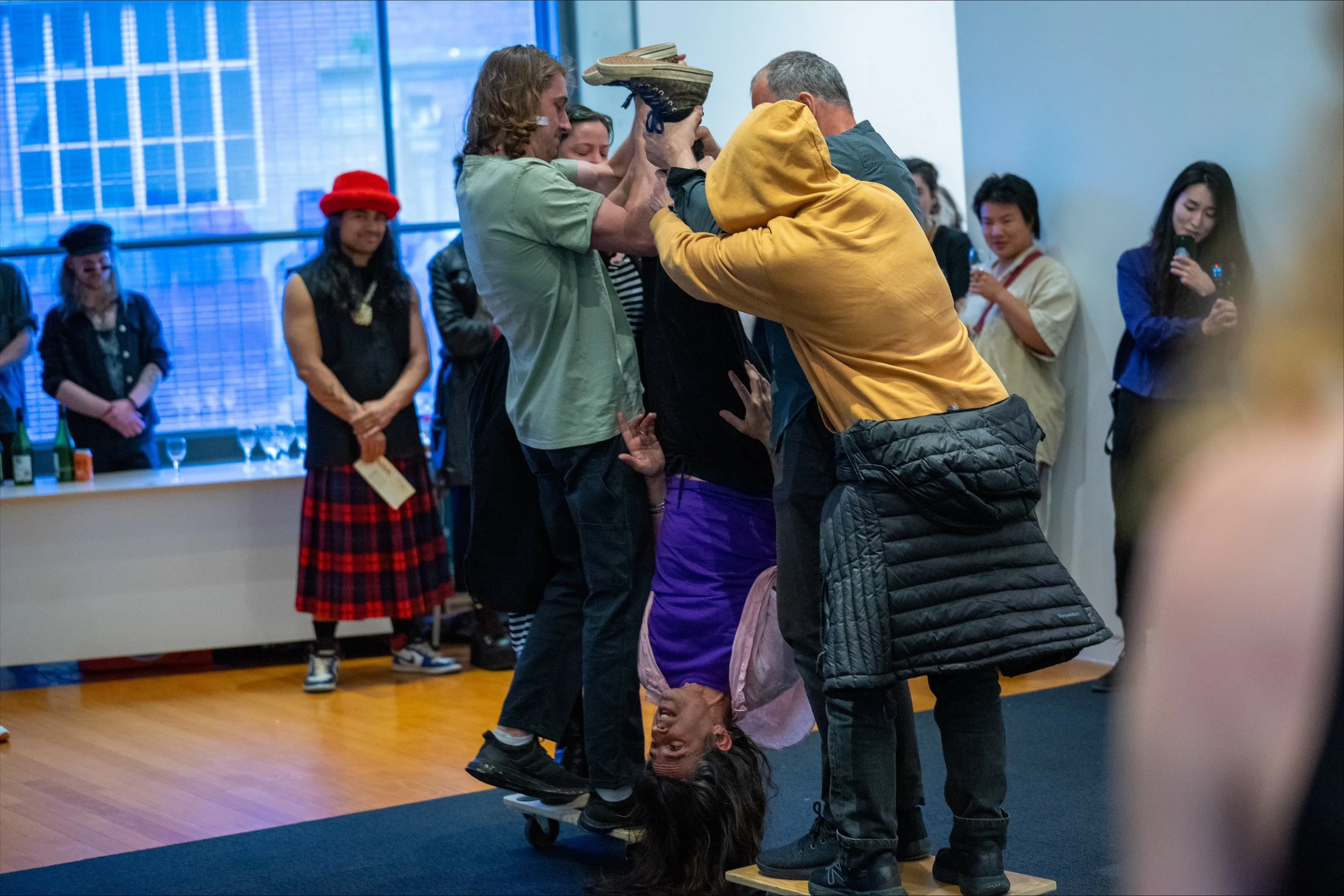PAWA 2023: Opening Night
This article is published in collaboration with Performance Art Week Aotearoa 2023. Showcasing performance artists from across Aotearoa and the world, Performance Art Week Aotearoa brings a stellar line-up of performance art works, workshops, discussion and happenings to Wellington city. Rat World is excited to platform a range of critical writing on the events from the year’s festival.
Photos by Robyn Jordaan
Performance Art Week Aotearoa returns in 2023 with a lineup of Māori, Moana and Tauiwi artists performing at opening night in the Adam Art Gallery Te Pātaka Toi. The Adam is a fitting venue to kick off PAWA; its unique architecture allows each artist their own space to perform, while also facilitating movement between levels. The gallery is also suitable on a curatorial level, having recently shown In Relation: Performance Works by Peter Roche & Linda Buis 1979–1985, curated by Gregory Burke and Christina Barton. This exhibition is notably one of the few dedicated to performance artists in a world that has historically disregarded performance as an art form. The kōrero around performance art in Aotearoa could be an essay on its own but suffice to say it is (like many things) underfunded and underappreciated. I have visited and worked in galleries that rightfully support cultural performances, but seem to have little time to engage with performance art. I have also spoken with performance artists who do not feel that they were fully supported when working in institutional spaces.
Entering the Adam, I wander past Louie Zalk-Neale's sculptural barrel, made by Adam Ben-Dror and filled with wai and pungapunga. Though they are fixed into place, the pungapunga allowed to sway in the artificial tide—small movements that mimic kāeo. I’m not aware at the time, but later find out that the artist has already begun their work in Boulcott Street. Wearing woven kawe made from tī koūka and sunglasses from the Warehouse, Zalk-Neale walks to the gallery while seven kōhatu trail behind them.
I’m still in the gallery, looking at a livestream of John Vea on the top floor while he performs an act of labour just one level down on the mezzanine. Kneeling on a thin black mat, Vea methodically stacks bricks one by one, slowly caging himself in the small space. Next to me, a friend comments that the act reminds her of prisoners being forced to build their own jails. Instead, I’m thinking of the many Moana and Māori men who make up our nation's workforce. The gruelling labour of oft overlooked people, whose repetitive motions gradually degrade their bodies. Many men in my whānau fit that bill—the older ones like my father now dealing with the consequences of a hard life's work. To watch something in person? Makes visible the inconspicuous mahi that we take for granted. Once Vea has used all the bricks at his disposal and only his head of curly hair is peeking out above the wall, he barely pauses before beginning to take them down and orders them into piles on each side of himself. Though he has technically removed the wall that encased him on the mezzanine, Vea still kneels with his body between the bricks. The artist then begins anew, rebuilding and dismantling again and again. I wonder now how many cycles Vea went through—I couldn’t stay to watch this performance the entire time but think it was around 7:30pm when he finished up, the aches of menial labour undoubtedly making their presence known.
Just after 6pm, Julieanna Preston arrives at the Adam’s foyer with a basket full of fabric and Bridget Williams Books in tow. She stands here, reading passages from the first book aloud as a small audience draws in close. Some of those surrounding Preston are past students. As an academic, she is well-known and respected in the field of performance art. Preston clearly knows her research in Māori–Pākehā relations and through restless manoeuvres seeks to interrogate the state of being Pākehā in Aotearoa. BWB has a solid reputation for short and impactful books that speak to the cultural diversity in this country. Titles that Preston reads include On Coming Home, Fragments of a Contested Past and This Pākehā Life. Throughout the night, I am reminded of my time studying here at Te Herenga Waka Victoria University of Wellington. Back when VicBooks was still open (R.I.P) you could have a tea/coffee/hot chocolate, sit down and read in between classes. In some courses, texts like Imagining Decolonisation and False Divides were integral to my assignments. They are still relevant now and I often find myself referring to them in professional research and writing. I also have less pleasant memories of being one of the few Māori students in a first year History tutorial, stuck speaking with debate bros™ about this country’s awful past. Preston’s performance reminds me that there are many Pākehā and Tauiwi making genuine efforts to understand how history has shaped Aotearoa and, in her words, “unsettle colonial hubris”. Preston continues reading aloud to us throughout the night, draping colourful fabric all over the Adam while she finds particular passages that interest her.
By 6:45pm, Louie Zalk-Neale has reached the gallery’s foyer and asked seven members of the public to assist them in carrying various kinds of kōhatu sourced from Kā Tiritiri o te Moana and Taranaki. Raised by parents who imparted to them the importance of te taiao, the artist has a deep respect of the whenua. Heraclitus said you cannot step in the same river twice and I’d argue that you can't experience the same performance artwork twice either. Although Beyond your tadpole stage // Your spinal cord dissolves was commissioned by Gus Fisher Gallery and first activated there, Louie has since travelled to our shared papakāinga in Tauranga, a more ancient homeland of Taiwan and the land of our close cousins in Rarotanga. They have engaged with locals and te taiao in each of these locations, gaining knowledge of our peoples shared history while coming to the realisation that their “art practice is pretty tightly bound to the whenua and people in Aotearoa” (email correspondence with the artist). Collaboration is an intrinsic aspect of Zalk-Neale's artistic practice. They worked with Tāwhanga Nopera, Neke Moa and Adam Ben-Dror in the creation of the work’s sculptural elements and for the first iteration of this performance and had several aides on opening night at the Adam. These aides carry the kōhatu into the gallery before being signalled to place them down atop cushions on the floor. Zalk-Neale then drifts around the barrel, spending time with each kōhatu—lovingly untangling the taura and fixing the cushions that the kōhatu sit on. Ancestral knowledge and mauri reside in each one. After the performance, they tell me about the creation of the biggest pounamu, made by Neke Moa and her partner. It is carved with an ancient Taranaki pūrākau, said to be from a time before even Ranginui and Papatūānuku. Seashells adorning the taura symbolise a part of this pūrākau that claim there was an entire plane of them in being once, emblematic of the importance the moana has always had in te ao Māori. In the same email I mentioned earlier, they proclaimed that “whakapapa goes way beyond that too [literal ancestral links], and queers are somehow born everywhere, like dolphins from fish eggs”. Zalk-Neale's takatāpuitanga is of course an integral element to their mahi toi, an added layer of relationality to this land and its people.
At around 7:30pm on the Adam’s top floor, Tomasz Szrama begins his performance. With a lengthy CV including performances in Denmark, China, Estonia, Poland, Greenland, Northern Ireland and Taiwan (and that’s just 2023), Szrama comes to Aotearoa for PAWA. The artist provides an injection of energy into the night, engaging with the audience by entrusting them with his body. Szrama begins by being suspended upside down—one person holding each of his legs—and carried through the gallery while his aides stand on rolling platforms. He improvises with found materials, including a knife, golden syrup and a bottle of wine, but before he can be tipped over the upper gallery’s ledge, the Acting Director steps in with (understandable) safety concerns. Some light-hearted booing later, Szrama spreads golden syrup on the ledge before getting his aides to lift him and move his body across so that he can lick it up. Another suspension involves a plank, a rod with the aforementioned knife dangling off its string and more aides helping Szrama to clench it between his teeth as half of his body leans over a different ledge. The artist’s frantic improvisations continue as he corrals members of the public into assisting in the performance. I look around and am impressed at how Szrama has managed to get a crowd of stereotypically reserved New Zealanders involved in his work. The golden syrup features again when someone squeezes half of the 500g bottle into his mouth/on his face before he submerges his head into a tub filled with water in the pursuit of that knife. As Szrama emerges victorious—knife in mouth yet again—the crowd cheers. Risks taken and avoided.
Overall, the night had a well-chosen mix of artists, each offering something unique. Opening night is just the start of an exciting week ahead, with more international and Aotearoa performance artists lined up in the coming days. PAWA is the result of a small and dedicated group of people, led by Sara Cowdell, who provide opportunities for performance artists to share their work, audiences to experience it and writers to write about it.
■
Brooke Pou (Ngāpuhi, Ngāi Te Rangi) is a curator from Te Whanganui-a-Tara. She is currently Curator at Enjoy Contemporary Art Space while completing her Masters thesis in Art History. Her research and writing interests include wāhine Māori and Moana artists, exhibitions and curators, as well as global Indigeneity, connections throughout Te Moana-nui-a-Kiwa, textile art and performance
This piece was originally published on www.performanceartweekaotearoa.com - check out their website for more information about the 2023 festival.
Glossary
Kai - food
Kāeo - sea tulips
Kōhatu - rocks
Kōrero - conversation
Mahi toi - artwork
Mauri - life force
Papakāinga - original home
Pungapunga - pumice stones
Pūrākau - legend
Takatāpuitanga - a traditional term that embraces Māori with diverse gender identity or sexuality
Taura - rope
Te taiao - the environment
Wai - water
Whānau - family
Whenua - land
Whakapapa - genealogy





